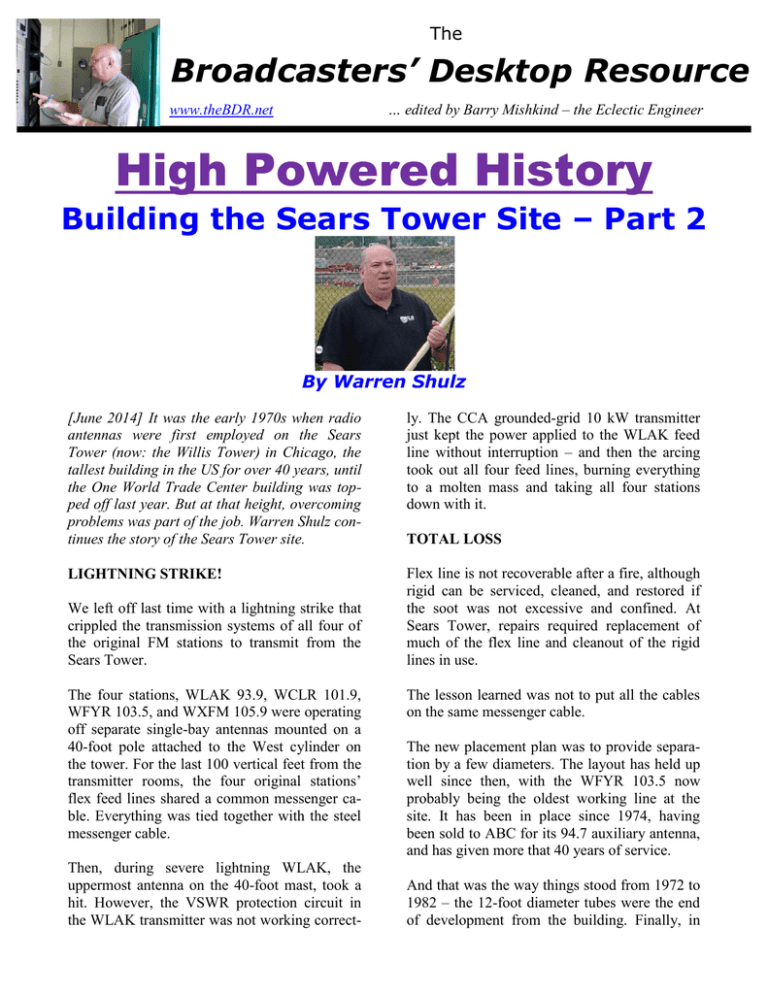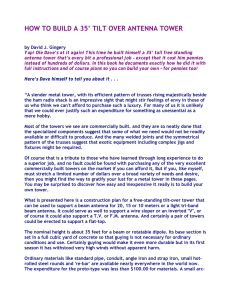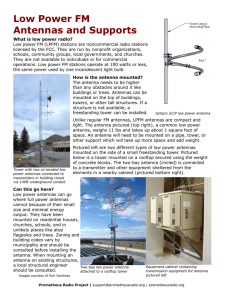6/5/14 - The Broadcasters` Desktop Resource
advertisement

The Broadcasters’ Desktop Resource … edited by Barry Mishkind – the Eclectic Engineer www.theBDR.net High Powered History Building the Sears Tower Site – Part 2 By Warren Shulz [June 2014] It was the early 1970s when radio antennas were first employed on the Sears Tower (now: the Willis Tower) in Chicago, the tallest building in the US for over 40 years, until the One World Trade Center building was topped off last year. But at that height, overcoming problems was part of the job. Warren Shulz continues the story of the Sears Tower site. ly. The CCA grounded-grid 10 kW transmitter just kept the power applied to the WLAK feed line without interruption – and then the arcing took out all four feed lines, burning everything to a molten mass and taking all four stations down with it. LIGHTNING STRIKE! Flex line is not recoverable after a fire, although rigid can be serviced, cleaned, and restored if the soot was not excessive and confined. At Sears Tower, repairs required replacement of much of the flex line and cleanout of the rigid lines in use. We left off last time with a lightning strike that crippled the transmission systems of all four of the original FM stations to transmit from the Sears Tower. The four stations, WLAK 93.9, WCLR 101.9, WFYR 103.5, and WXFM 105.9 were operating off separate single-bay antennas mounted on a 40-foot pole attached to the West cylinder on the tower. For the last 100 vertical feet from the transmitter rooms, the four original stations’ flex feed lines shared a common messenger cable. Everything was tied together with the steel messenger cable. Then, during severe lightning WLAK, the uppermost antenna on the 40-foot mast, took a hit. However, the VSWR protection circuit in the WLAK transmitter was not working correct- TOTAL LOSS The lesson learned was not to put all the cables on the same messenger cable. The new placement plan was to provide separation by a few diameters. The layout has held up well since then, with the WFYR 103.5 now probably being the oldest working line at the site. It has been in place since 1974, having been sold to ABC for its 94.7 auxiliary antenna, and has given more that 40 years of service. And that was the way things stood from 1972 to 1982 – the 12-foot diameter tubes were the end of development from the building. Finally, in 1982, a group TV broadcasters decided to develop the site. area: if I placed my foot on the mounting base of the 20-foot pole with two FM antennas, significant RF heating could be felt via whole body exposure in the near field of the antenna. It was an obvious RF hot spot until the antennas were moved away from the area. TV GROUP DEVELOPS A PLAN It was Fred Eychaner’s plan to move Channel 50 (WPWR-TV) from Gary, IN to Chicago that provided the pressure to develop TV antenna support towers. (Eychaner bankrolled the project, which would net him $425 million when he sold WPWR to Fox in 2002.) These four temporary antennas operated in this location for at least 18 months. Coverage to the East was near zero as the metal skin of the 110th floor penthouse provided a solid shield. A group formed by Channels 7, 11, 26, and 50, along with the FM stations soon got the project green-lit. In 1982, two 256-foot towers were installed on top of the Sears Tower, lifting its total height from 1,451 feet to 1,707 feet (520.3 m). The plan was to stack tower sections using a helicopter. AN FM MASTER ANTENNA A committee of the four legacy FM broadcasters and a new arrival – a ABC/Cap Cities station WYTZ - 94.7 (engineered by the late Harry Preister) was added to the original group of four – began work on an FM Master Antenna. Other stations were contacted, but as costs were in the area of $300k to develop a transmitter site and most FM's operators already had reasonable sites at Hancock that had cost a fortune, most decided not to spend any more money. This five-station group committed to developing the new FM antenna plan for the site. The TV broadcasters arrived at a total aperture value in 1982 of $336,000, or an aperture fee of $42,000 to own one of the eight sections of the tower for FM station antenna slots. During construction, the TV group needed to get the 40-foot FM pole out of the way of the tower build-out. To that end the pole was removed and broken into two sections of 20-feet each, then welded to the lift anchors on the 110th floor’s roof. The four FM stations then were permitted to resume broadcast operation from the 110th floor roof under an STA. To make everything fit, the original group of five stations had to notch all eight mounting locations as the vertical braces spanned a 20foot space. The fiberglass I-beam had to be cut back in critical fit areas to clear the cavity back radiator (CBR) on each tower face and stiffened. Each fiberglass I-beam was supported with Oak wood laminated into the support arm brackets but not near the baskets. As it turned out the inside of the radome should have been not 11 feet but 11 feet, 6 inches for full clearance. Again, recall that this was before RF exposure limits. You had four stations each with a nominal 4.5 kW ERP at a location where you could actually walk right up to it. It truly was a hot RF To avoid any future disruptions in station operations when the three empty slots were eventually filled, the original five FMs bankrolled the cost (about $10,500 for each unoccupied slot) to The 256 foot towers were placed by helicopter 2 modify the radomes for the three unassigned apertures, including the vertical fiberglass I-beams that support the radome cover attachment to the tower and the vertical bars that attached the Harris CBR antenna to the tower face. The money would be recouped when new stations eventually arrived. radome enclosure. It was later proven that an 11 foot, 6 inch clearance was needed. This call to Harris effectively defined the antenna supplier because of the radome fit. It would have been possible chose another antenna and custom fit the radomes – that is what was done by analog Channel 5 – but, as expected, it was it ended up being quite an expensive affair. The three open slots then were ready to accept a CBR antenna without the need to remove the radome covers to remove the fiberglass I-beams for undercutting at that future date. Ultimately, WFMT, WJMK, and WBBM-FM took the slots. LIMITED CHOICES The process for the FM antenna selection was a little backward: like having a shoe looking for a foot – the fit was dictated by radome enclosure. PLACING THE MASTER ANTENNA Eventually some nine different manufacturers and/or designs were considered. As noted, the choice of the Harris CBR module was basically pre-determined by the structural engineer’s specifications for the radome arms and radome clearances. At the time, RCA was also in the mix to develop a master antenna plan. The late Dr. Matti Siukola was the Antenna Engineering Manager from RCA but they never gained traction for a plan for the master site. However, Siukola did establish that it was best to put all the UHF antennas on the West tower and the VHF antennas on the East tower. Why? It was thought the VHF antenna field was better able to look through an object as opposed to having reflections come from an object. Thus most UHF antenna would null to the East (over Lake Michigan) without getting reflection from the East tower, which was just 90 feet away. The costs of the single antenna approach were high. On the other hand the cost of a diplexer also was high – and no particular space was at hand for a large diplexer. Furthermore, in that period diplexing had failure issues. The FM engineers questioned the potential effects of the East mast being that close. But in the end it was decided to just let it go – nothing could be done except to acknowledge there would be a pattern distortion. SIZE MATTERS At the time there was no suitable FM antenna in hand. However, Asrow (the structural engineer) spoke with Harris. Based on a casual telephone call, they determined we needed an eight-foot triangular tower and a Harris Cavity Back Radiator (TV-6 antenna) (CBR) which required an 11-foot This photo shows the wooden oak bracing added to the connection points of the radome cover. 3 Once the construction was finished, the ongoing maintenance costs were allocated by the vertical aperture percentage compared to the total of all vertical apertures. This was one of the reasons why WLS-TV passed on space for a sidemounted horizontally-polarized antenna for the ABC FM station; it was to reduce the aperture maintenance cost. In our next installment we will take a closer look at the FM Master Antenna, how it was chosen, manufactured, and the pattern we were able to get from it. Inside a radome on the Sears Tower The sheet metal flaps seen are de-coupling chokes on the radome support arms. These were used in different lengths depending on antenna frequency. Apparently this was found to be necessary during full-size pattern testing to obtain the +/- 1.5 dB circularity specification. --Warren Shulz is enjoying the retired life now, after being Chief Engineer at WLS AM-FM for 22 years after 15 years at WFYR-RKO. Now, he is out enjoying RVing and riding his eBike. By doing this preparation work at the same time the first five slots were built, it avoided a total removal of the vertical fiberglass I-beams for notching and setting the mounting brackets for the three future antennas. When he is not out having fun, you can contact him at wshulz@cs.com --If you would like to know when Part 3 of the Sears Tower history is posted, be sure to sign up for the one-time-a-week BDR Newsletter. It only takes 30 seconds if you click here. Return to The BDR Menu 4



